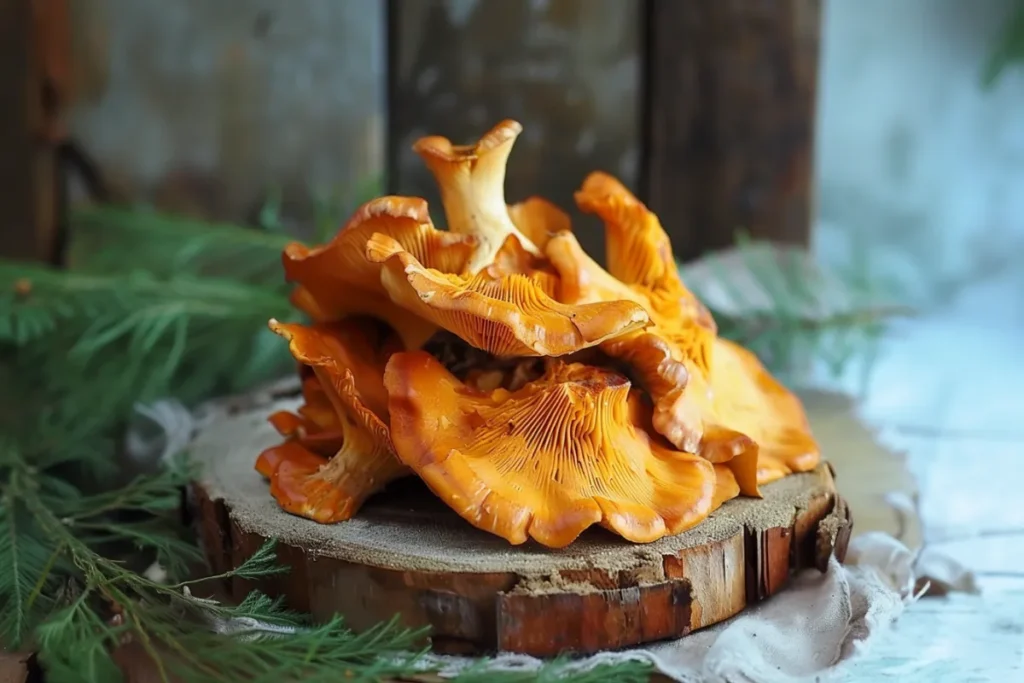oisonous Look-Alikes for Chicken of the Woods
Mushroom foraging has surged in popularity, with many enthusiasts searching for unique and edible varieties to enhance their meals. Among the most sought-after wild mushrooms is Chicken of the Woods (Laetiporus species)—a striking orange or yellow fungus prized for its meaty texture and chicken-like flavor.
However, foragers must exercise caution. Poisonous look-alikes for Chicken of the Woods exist, and misidentifying them can lead to serious health risks. Ensuring proper identification is crucial to a safe and enjoyable foraging experience.
In this guide, we’ll explore how to accurately identify Chicken of the Woods, distinguish it from potential toxic look-alikes, and take precautions to avoid dangerous mistakes in the field.
What Is Chicken of the Woods Mushroom?
Chicken of the Woods is a type of bracket fungus, commonly found growing in large clusters on the trunks of hardwood trees like oak and chestnut. It’s easily recognizable by its distinctive bright yellow-orange color and its overlapping, shelf-like structure. The texture of this mushroom is what gives it its name—it’s often said to have the consistency and taste of chicken, making it a perfect meat substitute in many dishes.
Key Characteristics of Chicken of the Woods:

- Color: Ranges from bright yellow to orange.
- Texture: Soft, spongy, and sometimes meaty.
- Growth pattern: It grows in large, fan-like clusters, typically on decaying wood.
- Season: Found during late summer and fall, although it can grow earlier depending on the climate.
- Tree association: Often grows on hardwoods, especially oak, but can occasionally be found on other trees.
While its bright color makes it relatively easy to identify, many mushrooms can share similar characteristics. This makes it critical to learn how to differentiate Chicken of the Woods from its poisonous look-alikes.
Culinary Uses and Nutritional Benefits
Chicken of the Woods is widely prized in the culinary world due to its rich, savory flavor and versatile cooking applications. It can be grilled, sautéed, fried, or even baked, making it an excellent addition to dishes like tacos, stir-fries, and soups. Beyond taste, this mushroom offers a number of nutritional benefits, including:
- High protein content, making it a popular meat substitute.
- Rich in fiber, which promotes digestive health.
- Loaded with antioxidants, which help reduce inflammation and support overall wellness.
To expand your culinary repertoire, consider pairing Chicken of the Woods with other hearty proteins or unique ingredients. For example, explore this delicious Bison Burger Recipe for a flavor-packed alternative that’s equally nutritious and hearty.
Poisonous Look-Alikes for Chicken of the Woods Mushroom

Before heading out into the wild to forage, it’s essential to brush up on foraging safety and identification techniques. Proper identification can be the difference between a delicious, nutrient-packed meal and a dangerous, potentially life-threatening experience. Here are some tips for foraging Chicken of the Woods:
How to Identify Chicken of the Woods
When foraging, always take a cautious and systematic approach to identifying mushrooms. Chicken of the Woods is known for its vibrant color and unique structure, but look for the following specific traits to be sure:
- Color: The bright yellow or orange hues are key identifiers. Avoid mushrooms with significantly duller colors or any unusual markings.
- Pores instead of Gills: One distinguishing feature of Chicken of the Woods is the presence of tiny pores on its underside, as opposed to gills. This is one of the most reliable ways to differentiate it from some poisonous species.
- Texture: When fresh, the mushroom should be soft and spongy to the touch. As it matures, it may become tougher, but avoid specimens that feel overly dry or brittle.
- Growth Location: Pay attention to where the mushroom is growing. If it’s growing on hardwood trees like oak, that’s a good sign. However, be cautious with specimens found on coniferous trees or eucalyptus, as these species may cause gastrointestinal issues.
For further guidance on foraging and mushroom identification, be sure to explore resources like this Beginner’s Guide to Mushroom Identification, which provides expert tips for safely identifying and harvesting mushrooms in the wild.
Common Mistakes When Foraging Chicken of the Woods
Even experienced foragers can make mistakes, so it’s important to stay vigilant and mindful of the following:
- Ignoring Growth Environment: While Chicken of the Woods primarily grows on hardwoods, some poisonous species grow in similar conditions but on different trees. Always check the type of tree before harvesting.
- Overlooking Differences in Texture: Young Chicken of the Woods mushrooms are soft and pliable, but older specimens can become woody or tough. Avoid overly mature mushrooms, as they are less palatable and harder to digest.
- Harvesting Without Confirmation: If you’re uncertain whether the mushroom you’ve found is indeed Chicken of the Woods, don’t harvest it. Always double-check identification through multiple sources or consult with experienced foragers.
Poisonous Look-Alikes of Chicken of the Woods
While Chicken of the Woods is relatively easy to identify, there are a few mushrooms that can be mistaken for it—some of which are poisonous. Misidentifying these mushrooms could lead to serious health risks, so it’s crucial to understand the key differences between Chicken of the Woods and its look-alikes.
1. Jack-O’-Lantern Mushroom (Omphalotus olearius)
The Jack-O’-Lantern Mushroom is one of the most notorious look-alikes of Chicken of the Woods. It’s known for its bright orange color, which can easily confuse novice foragers.
- Appearance: The Jack-O’-Lantern is bright orange and grows in clusters at the base of trees, much like Chicken of the Woods.
- Key Difference: The primary difference is that Jack-O’-Lantern mushrooms have true gills, whereas Chicken of the Woods has pores. The Jack-O’-Lantern’s gills run all the way down the stem, making it a clear indicator if you look closely.
- Toxicity: Consuming Jack-O’-Lantern mushrooms can result in severe gastrointestinal distress, including vomiting, diarrhea, and cramps.
2. Sulphur Shelf Variants (Other Laetiporus Species)
While Chicken of the Woods is a specific type of Laetiporus mushroom, there are other species in the same genus that may cause gastrointestinal issues.
- Appearance: Some Laetiporus species look almost identical to Chicken of the Woods, but the key difference is where they grow. Chicken of the Woods typically grows on hardwood trees, while these variants can be found on conifers or eucalyptus.
- Toxicity: Mushrooms from coniferous trees are often inedible and can cause mild to severe stomach upset if consumed.
3. Velvet Foot (Flammulina velutipes)
Another mushroom sometimes mistaken for Chicken of the Woods is the Velvet Foot, also known as Enokitake when cultivated.
- Appearance: The Velvet Foot has brownish or orange caps with a velvety texture on the stem.
- Key Difference: While it may resemble Chicken of the Woods in color, the shape and texture of the mushroom are different. Velvet Foot tends to grow in colder weather and has a distinct brownish stem.
- Toxicity: While not always poisonous, Velvet Foot can cause stomach upset if consumed raw. It’s crucial to distinguish it from Chicken of the Woods.
How to Tell Chicken of the Woods Apart from Poisonous Look-Alikes
Identifying Chicken of the Woods requires a keen eye and attention to detail. Here are a few tips to help you differentiate between Chicken of the Woods and its poisonous look-alikes:
Check for Pores, Not Gills
One of the clearest distinctions between Chicken of the Woods and some of its poisonous counterparts, like the Jack-O’-Lantern Mushroom, is the presence of pores on the underside of the mushroom. Chicken of the Woods has a spongy texture and small pores, while the Jack-O’-Lantern and other toxic mushrooms have gills.
Perform a Spore Print Test
A spore print test can be helpful in distinguishing Chicken of the Woods from its toxic look-alikes. To do this, cut off a portion of the mushroom cap and place it gill-side down on a piece of paper. The color of the spores will provide an additional clue for identification. Chicken of the Woods typically produces a white spore print, while other species may produce different colors.
Common Mistakes in Identifying Chicken of the Woods Mushroom
The smell and texture of a mushroom can also provide critical clues. Chicken of the Woods often has a pleasant, slightly sweet smell, whereas some poisonous mushrooms may smell foul or have a more earthy odor. The texture of Chicken of the Woods is also distinctive—it should be soft and slightly spongy when fresh, whereas look-alikes like Velvet Foot have


